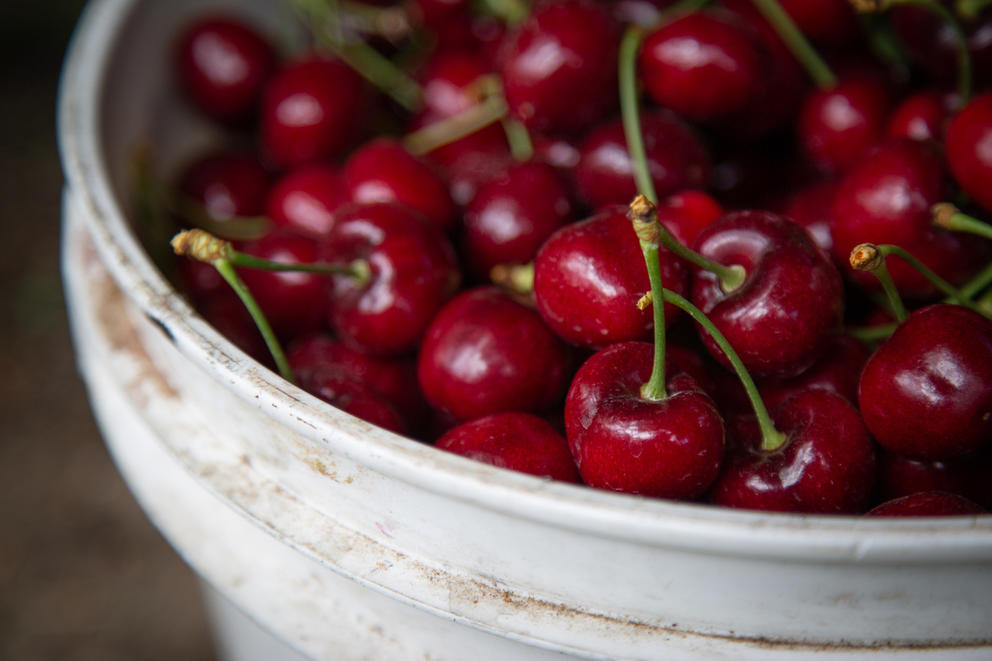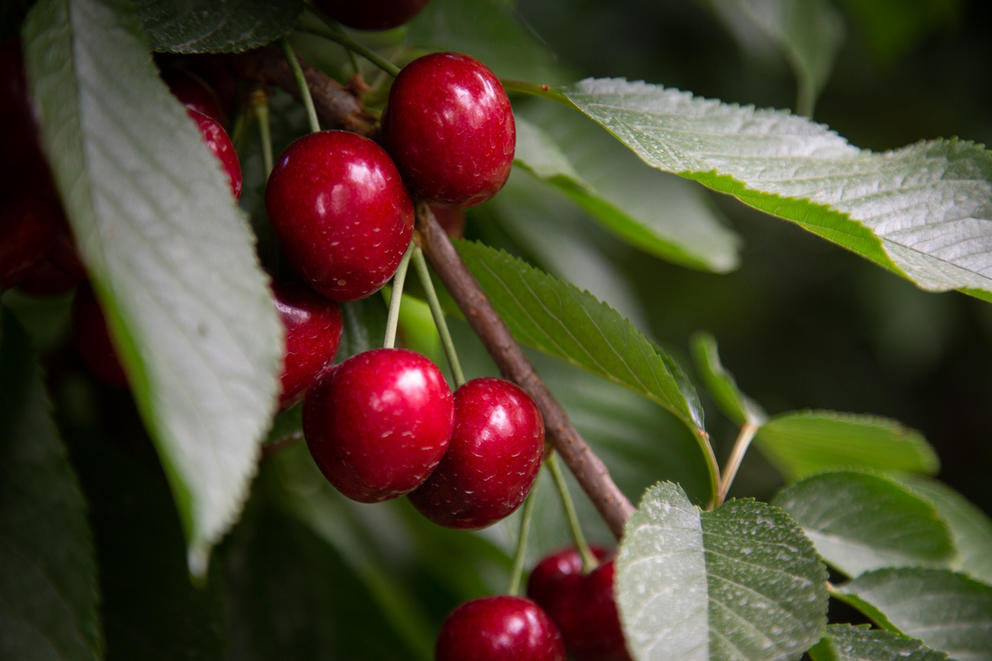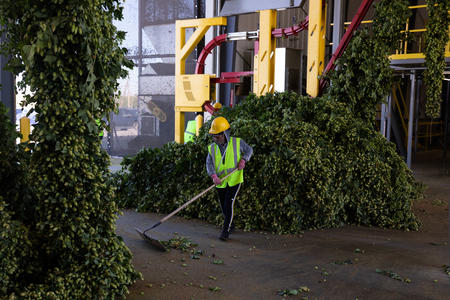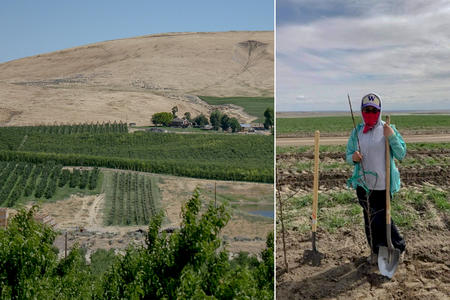Snowy and cold conditions in April caused the farm to lose 98% of its cherry crop, which makes up a sizable portion of the 126-acre orchard. That means fewer cherries to sell at the farmers markets in Seattle, Eastern Washington and Idaho.
Cherry growers in Washington state, who produce the majority of Northwest sweet cherries, often have to respond to weather conditions — frost during the early months of 2020 or triple-digit temperatures in late June last year that damaged ripening fruit.
This year, the cold and wet spring stunted the development of many cherries, leading to what looks to be the smallest crop of Northwest sweet cherries in nearly a decade.
That will likely mean higher prices at local grocery stories and farmers markets. And with cherries taking longer to develop, harvest has been delayed by several weeks, meaning consumers in the Northwest — and throughout the U.S. — have to wait longer to get their first taste of the juicy red fruit.
“It’s unprecedented,” said Kurt Tonnemaker, who oversees sales efforts of his family’s two farms, in Royal City and Woodinville. “It’s hard to plan for that.”
Nearly 15 million 20-pound boxes are expected to come from growers in the five-state region — Washington, Oregon, Idaho, Utah and Montana, according to the latest estimate of the Northwest Cherry Growers, the Yakima-based marketing organization.
If the estimate sticks, that would be nearly a quarter less than the 20.3 million boxes harvested a year ago and the smallest crop since 2013, when the region produced just 14.3 million boxes.
The recent rain that soaked the region also stunted an already delayed harvest. Some growers in early season areas — including orchards in Pasco and Mattawa — did some picking on Friday, but had to stop for several days because of rain, said B.J. Thurlby, president of the Northwest Cherry Growers.
Growers will find out later this week whether last week’s weather damaged the cherries, he said.
Rain can cause nearly ripened cherries to split open, which makes them no longer worth picking because they can’t be sold.
“There’s a possibility the crop can be whittled down even more,” said Frank Lyall, a Yakima Valley cherry grower.
It will likely be a few weeks before a sizable volume of cherries shows up at farmers markets and grocery stores around the Pacific Northwest and potentially even longer in other parts of the U.S., Thurlby said.
Weather’s impact
The state’s early and midseason cherry-growing regions, including the Tri-Cities and Yakima Valley areas, experienced mild temperatures earlier this year, which caused trees to bloom sooner than usual.
But in April — to the unfortunate surprise of growers — many regions were hit by a cold snap, along with snow, which damaged cherries in bloom. Further damage came from poor pollination activity caused by cold and wet conditions, which kept many cherries on the tree from developing at all and delaying others.
The timing of such adverse weather conditions also means the impact has been quite uneven. Some growers, such as the Tonnemaker family in Royal City, experienced a near-total loss. Growers in higher-elevation areas, which grow fruit that won’t be ready until later in the summer, are expected to have relatively minimal loss because their cherry trees were not far enough in bloom to sustain damage.
Other cherry producers will likely see some damage, though not to the extent of growers such as the Tonnemaker family.
Lyall, the Yakima Valley grower, expects a below-average harvest at his cherry orchards in Mattawa, Desert Aire and North Prosser. He estimates that he may have lost over a quarter to a third of his crop, but won’t know the extent of the loss until the harvest is done at the end of July.
Still, there are plenty of cherries to harvest, as he has a variety of cherries under different growing seasons. He notes that his crop of Rainiers — the popular cherries with yellow-red flesh — look healthy compared with some of his red varieties. Plenty of late-season cherries, which won’t be picked until the end of July, remain on the trees.
“It’s always highly dependent on variety and location,” he said.
Lyall isn’t just worried about the weather. He’s also concerned about inflation. Fuel costs are skyrocketing, and the prices of pesticides and other items used for production are going up. Some of those costs will be passed on to cherry fans. Lyall is concerned customers may buy fewer cherries, which industry officials say often are part of an impulse purchase.
“They only have so many discretionary dollars,” Lyall said. “By the time people are through paying for bread and fundamental necessities, they won’t be able to afford relatively more expensive fruits and vegetables. That could impact the more expensive crops of Eastern Washington.”
How the market will respond
While customers will have to pay more for cherries this year, raising prices to cover costs throughout the production process and pricing shoppers out aren’t necessarily the best option for retailers or growers selling directly to customers at farmers markets.
Figuring out how to maintain a profit while avoiding alienating shoppers on a budget is crucial for the state’s food retailers, be it local farmers markets, growers curating farm boxes for consumers or national grocery chains.
Neighborhood farmers markets sell a smaller percentage of the crop compared with grocery chains. However, the importance of Northwest cherries to their bottom line remains the same for both.
For larger chains, revenue projections in the produce category are based on the volume of different crops in previous years, said Ken Bethea, produce and floral field merchandiser at QFC, the grocery chain owned by Kroger.
With several million fewer boxes of Northwest cherries expected this year, that means an absence of tens of millions of dollars in sales for grocery stores, he said.
Retailers like QFC will have to pivot promotions planned for cherries to other Washington-grown fruits, such as peaches and nectarines, to draw shoppers in, he said.
It’s unlikely shoppers will see loss-leader pricing, which are promotional prices — think of those 99-cent to $1.49-a-pound sales — grocery stores adopt to draw people to their stores.
At the same time, grocery chains, especially those in locations where customers have more limited incomes, must be careful when increasing prices.
QFC’s Bethea said retailers would focus on keeping the “everyday price” down — $2.99 to $3.99 a pound for red cherries — for most of the season and have limited promotions where prices can drop slightly below that. Rainier cherries, the popular yellow-red variety, will be a little more expensive than that, but not to the point that they’re inaccessible for shoppers.
“We don’t want to price any family out of cherries on [price],” he said.
Sales and the number of shopper visits increase when cherries and berries are available, which marks the start of warmer and drier weather after months of rain, said Jennifer Antos, executive director of Seattle Neighborhood Farmers Markets, which runs several seasonal and year-round markets.
There’s been a limited amount of cherries available at some of her markets — through vendors that grow them in greenhouses or who had early-season cherries ready to pick. Otherwise, it’s slim pickings until late June or even early July, Antos said.
The delay in cherry availability is an educational opportunity about seasonal eating for shoppers interested in learning how their food is grown, she said.
“We’re talking — through our newsletter and our social posts — about why cherries aren’t on the table yet and give some consumer education about how the weather is affecting growers,” she said.
Aside from customer education, Seattle Neighborhood Farmers Markets also helps its vendors survive tough times, including weather damage. The organization’s Good Farmer Fund awarded anywhere from $15,000 to $60,000 in grants in four of the last five years. Six to nine vendors received grants in each of those years.
At the pandemic's peak in 2020, the organization awarded more than $308,000 in grants to 72 vendors affected by closures and other government restrictions.
The award amount each year “really ranges,” Antos said. “It speaks to how unpredictable farming can be and how significant even a small event can be for a grower who is working on a small scale.”
Many growers also are diversifying where or which products they sell to better deal with adversity, said Colleen Donovan, executive director of the Washington State Farmers Market Association, a trade association made up of 115 farmers markets statewide.
Some farmers may grow exclusively to sell at farmers markets, while others opt to sell both at a farmers market or wholesale. Cherry growers, for example, may also sell to a fruit packaging house that sorts the fruit into bags or clamshell containers and distributes them to retailers.
“There’s no one-size-fits-all,” Donovan said about how growers approach selling their fruit.
Kurt Tonnemaker of Tonnemaker Hill and Tonnemaker Valley farms said his family has been able to continue selling other produce and groceries, including in-season asparagus and rhubarb, but also frozen cherries and dehydrated fruit leather made with fruit picked last season.
Tonnemaker also sells vegetables and herbs he grows at his farm in Woodinville. And while cherries are gone from the Royal City orchard, there’s still plenty of other soft fruit such as peaches to sell in the coming months.
Still, the family will feel the loss of cherries as the crop makes up roughly a tenth of the family farm’s income for the year, he said.
“They are a high-market item when you have them,” he said. “They bring in a lot of cash at the beginning of the season.”
But the Tonnemaker family is no stranger to dealing with — and surviving — adverse weather conditions. Thirty years ago, Kurt Tonnemaker launched the family’s now successful direct sales business. That year, rain wiped out the family’s newly planted cherry crop in Eastern Washington.
“It’s the 30th anniversary of losing our cherries,” he quipped.
Cherries expected to linger for longer
In email newsletters, the Northwest Cherry Growers emphasized the positives amid a challenging growing season.
One is the high quality of the fruit, which “should be a crop of dessert-quality fruit,” the organization wrote in its June 10 newsletter.
Industry officials have noted with more late-season cherries coming to harvest, supply could last longer than usual.
There might not be as many cherries for the Fourth of July holiday, which is typically a significant promotional period for grocery stores. There could, however, be plenty of cherries not just for the rest of July, but into August and even September, said Thurlby, the Northwest Cherry Growers president.
That means a taste of summer may linger at grocery stores and local farmers markets, as the calendar approaches the fall months.








